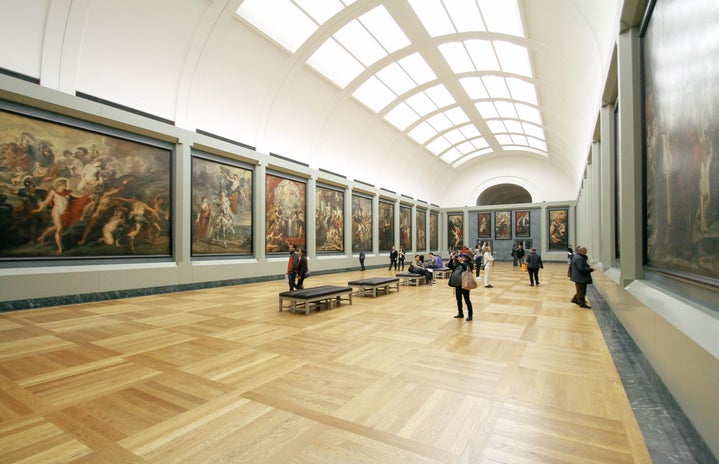Lari Pittman’s art show opened Saturday, November 9th, at Regen Projects in Hollywood. This show is comprised of 92 paintings, yet 3 of his featured works seem to effectively overshadow the other 89. These three works are in a series called “Flying Carpets” and all measure 10 feet high and 30 feet wide. The reason for such an enormous scale could be the work’s theme of epic trauma, yet it remains to be seen whether such a large work is really more effective in conveying a message to the audience as opposed to a smaller, more manageable size. While “epic” implies something outside normal proportions or understanding, Pittman’s art doesn’t necessarily have to have such an enormous scale in order to show this idea. In fact, it could be argued that the larger a piece of art is, the more the piece relies on shock value as opposed to artistic skill in impressing the audience. In this way we can ask: does size determine value in art?
Another case of the effectiveness of large versus small art is demonstrated in some of Jackson Pollock’s work. Pollock’s “Number 1A”, a splattered painting that hangs in the Museum of Modern Art, measures at around 6 feet high and 9 feet wide. While not as large as Pittman’s works, this piece still dominates the room it is placed in and thus has a commanding presence. Viewer’s eyes are immediately drawn to this painting, yet this immediate attraction is not necessarily because of the aesthetic value of the piece. Instead, it is the size of the painting that at first attracts the viewer. A different splattered painting of Pollock’s, “Magic Lantern”, is featured in the Rhode Island School of Design Museum and measures 3.5 feet tall and 2 feet wide. This means that the square footage of this painting is almost 8 times smaller than the square footage of “Number 1A”.
Does the smaller size of “Magic Lantern” mean that it is less effective than “Number 1A”? I would argue that the smaller size of “Magic Lantern” gives the audience a more intimate and accessible look at Pollock’s splatter painting. The fact that the splattering is shown on such a small canvas creates a more chaotic feel, as if the paint is fighting the confines of the small canvas and trying to break out of the frame the painting is placed in. This energy is almost tangible, and the small size allows the viewer to take in this energy all at once. In contrast, the large size of “Number 1A” is impossible to take in all at once. Or, I should say it’s possible, but the viewer won’t get as detailed a view. While “Number 1A” truly is magnificent to look at, a large part of the painting’s magnificence comes from its enormous scale. It is thus the size of the canvas and not the painting that makes the largest impression on the view.
We may wonder why artists make such large paintings if they are not necessarily more effective than smaller paintings After all, larger canvases are more expensive and take more time to cover. Part of an artist’s reason for making larger paintings is that the artist is making the paintings specifically for a museum or a gallery. Only a couple centuries ago, paintings were made to adorn the walls of middle class families’ houses. The paintings that were made for houses had a significantly smaller scale because they were destined to be displayed in small rooms. Artists no longer have these limitations and now want their works to dominate as much wall space as possible. Size is about spectacle, entertainment, and perhaps shock value. Size, at the end of the day, makes an impression in the viewer that will last longer than the impression made from smaller work the viewer is likely to overlook.
So, does size matter? In a way, it does. However, size does not determine the aesthetic worth of a painting. Bigger is not necessarily better. It is important to remember as viewers that we must not be impressed with a painting simply because of its large scale. There are several other factors that need to be taken into account before we deem a painting successful. While size is the first thing we may notice, it is not the most important feature we should take away from the work of art.

